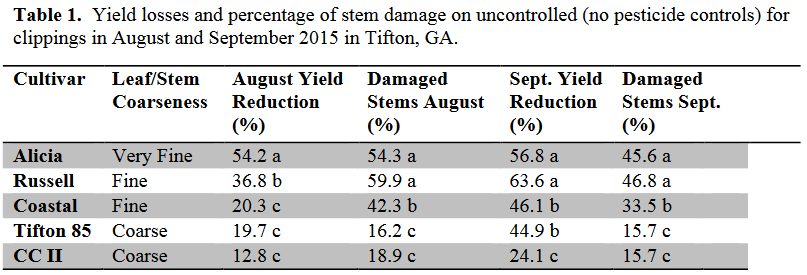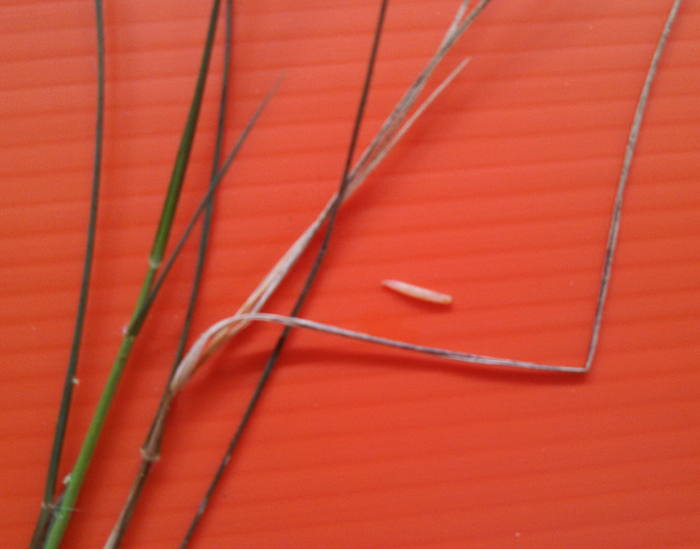
Bermudagrass Stem Maggots continue to be a cause of consternation to producers of high quality hay in the Panhandle in 2016. Research in Georgia indicates that, since their first discovery in that state in 2010, stem maggots have spread across the southeast. In Georgia the documented incidence of Bermudagrass Stem Maggot (BSM) has increased each year since. In 2015, some fields in Georgia reported 80% yield losses. In Gadsden County, it has been my observation that this is another year of increasing pressure from this pest.
Dr. Dennis Hancock at the University of Georgia conducted some interesting trials in Tifton, Georgia in 2015 (Table 1) that highlighted the potential yield losses from BSM in both fine and coarse stemmed varieties of bermudagrass. In their trial they compared yields and stem damage of plots that received control measures as opposed to plots with no control. Yield loses were high in the fine stemmed varieties, but significant yield losses occurred in the coarse stemmed varieties like Tifton 85 as well. Yield losses were also higher in September versus August in this study.


We still do not have a sure fire way to control the stem maggot and there is a lot of research to be done to quantify a more precise protocol. Damaged fields that are close to harvest (within 2 weeks) should be hayed or grazed. For now, in fields where producers have experienced previous losses, scouting for the adult flies and spraying when they are observed with two sprays of the lowest labelled rate of a pyrethroid for suppression is the best solution. Infested fields should receive the first application 7-10 days after harvest, followed by the second application 7-10 days after that.
For more information use the following publication links, or contact your local Extension office:
Bermudadgrass Stem Maggot – A New pest in Florida
University of Georgia 2016 Bermudagrass Stem Maggot Update
 0
0

Comments:
August 12, 2016
Great article! For the record, Dr. Bill Anderson conducted the research in Tifton. I was a collaborator, but it was Bill and his crew that put in the sweat equity.
March 19, 2016
Do you have a similar for dog fennels? Thank you in advance.
July 30, 2015
Thanks for these good suggestions, Alex.
June 20, 2014
Alex, I really appreciate your professional guidance. To the average person something like this causes panic just based on their look. A white, woolly mass is a great description for them! And as usual, you didn't make me wait for the help I needed! Thanks!
March 26, 2014
The pictures located at http://nwdistrict.ifas.ufl.edu/hort/2014/03/25/titi-in-bloom-this-spring/ are hyperlinked, but when I click on them I receive the following error: 404 - File or directory not found. The resource you are looking for might have been removed, had its name changed, or is temporarily unavailable. Could you please correct this oversight? Thanks. Dixie I.
December 9, 2013
Snails feed on plants but are not harmful to the garden unless present in large quantities. It is probably looking for a place to over winter. Bring a sample to your nearest extension office for ID.
December 8, 2013
Good morning. We found a small snail in the driveway here where we live in N.W. Florida. What do these snails eat? Are they harmful to plants?
Comments are closed.